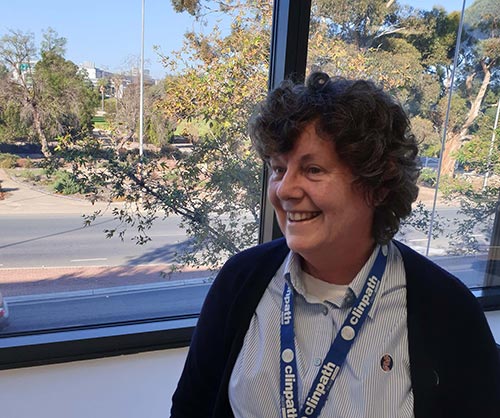Pathology couriers are non-medical transport drivers who collect and distribute pathology specimens between doctors’ surgeries, hospitals and pathology laboratories.
Pat Pitman is a pathology courier at Clinpath in South Australia. After 30 years in the job she knows the streets of Adelaide inside out and has earned the nickname PatNav. Pat gave us her perspective on what drew her to working in pathology and how things have changed over the years.
What attracted you to working as a pathology courier?
Way back when, I was dissatisfied with my employment and I saw a pathology courier car. A thought came into my head that I could do that job. So, I sent off expressions of interests in being employed by pathology companies and was called back for an interview.
My first job as a 16-year-old was delivering filled prescriptions to local nursing homes, community hospitals and the elderly on a push bike. I really enjoyed the work.
What does a typical day involve? How far do you usually drive in a day?
The day starts with preparing for the run; gathering reports, stores, checking the car for damage and setting it up for the day. There may be messages on the GPS system for extra calls to be incorporated in the run.
The mileage travelled in a day depends on the run. I do a lot of urgent runs, so 110-150 kilometres depending on whether it’s city urgent or outer metro. Some runs I can do 70 kilometres – others 300.
What makes your job enjoyable and satisfying?
It takes a team to make the company work. It doesn’t matter what skill you use, it all goes towards a result. I hope my contribution to the process helps to provide a quality service to the community and I feel satisfied and happy that I am being of use to people around me.
Do your family and friends understand much about pathology and what you do? How do you explain it to them?
My family and friends certainly do understand pathology and what I do. They know that I’m part of the process to getting a result to help GPs and specialists assess what is happening with our bodies. The results can show that our bodies are working well or there is something that needs further investigation. Pathologists are an important part of our overall health care. Every specimen that we carry is important, even the humble urine, as it may provide the clue as to why poor Aunt Flo is acting strangely. Also, another important part of our industry is transporting blood products. So sometimes we carry what is needed to put back into the body to sustain life.
Are there any common misconceptions you come across about pathology and what goes on behind the scenes?
I think one misconception is the length of time it takes to get a result. People think they can have a test in the morning and all the results for the doctor will be ready in the afternoon*. There is little knowledge of the process that specimen goes through to achieve a result. It has to be collected (prepared for transport), transported, and then processed through the lab. The pathologists and scientists look at the specimens and formulate what result should be given. It can be a high pressured and labour-intensive industry.
What do you enjoy doing outside of work?
When I’m not at work, I like going for drives with my daughters and grandchildren. Catching up with friends over a meal out or a movie on the big screen. I sometimes watch TV (not often though) and if not too tired, I may even read a few chapters of a book!
*(Although some results can be returned to doctors within very short timeframes this is not always the case and is dependent on several factors including the type of test and geographical location.)

